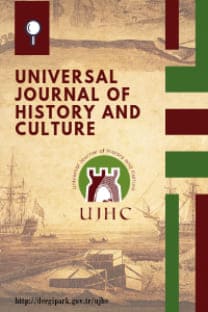Colonial Attempts to Control and Overcome Nature in Prospero's Daughter
Elizabeth Nunez is a postcolonial writer whose writings centre on such subject matters as racism, gender, colonialism and identity that often concern the setting of America and the Caribbean islands. Her novel Prospero’s Daughter pieces together a variety of subject matters that incorporates master-slave relationship, oppression and intersection of race and social status in the Caribbean. It is also possible to treat the novel with reference to nature and what it inspires for the white man and the native people. The author unfolds the white man’s presumption that nature acts as a source of disease and evil and assumes the role of an enemy that operates against him. For the white man, animals in Trinidad as in other tropical lands also pose threat because of their potential to poison and sting. According to the colonial mindset, nature in the island needs to be controlled and civilized by altering its flora through botanic gardens. In the novel, the garden stands for the colonial ambition to defy nature with the help of certain devices which can preserve plants inside from harsh climate conditions outside. The garden becomes the symbol of taking possession of the island and is reflected as a space in which the Western political, temporal and spatial norms are pervasive.
Anahtar Kelimeler:
Elizabeth Nunez, Colonialism, Nature, Plants, Botanic Garden
Colonial Attempts to Control and Overcome Nature in Prospero’s Daughter
Elizabeth Nunez is a postcolonial writer whose writings centre on such subject matters as racism, gender, colonialism and identity that often concern the setting of America and the Caribbean islands. Her novel Prospero’s Daughter pieces together a variety of subject matters that incorporates master-slave relationship, oppression and intersection of race and social status in the Caribbean. It is also possible to treat the novel with reference to nature and what it inspires for the white man and the native people. The author unfolds the white man’s presumption that nature acts as a source of disease and evil and assumes the role of an enemy that operates against him. For the white man, animals in Trinidad as in other tropical lands also pose threat because of their potential to poison and sting. According to the colonial mindset, nature in the island needs to be controlled and civilized by altering its flora through botanic gardens. In the novel, the garden stands for the colonial ambition to defy nature with the help of certain devices which can preserve plants inside from harsh climate conditions outside. The garden becomes the symbol of taking possession of the island and is reflected as a space in which the Western political, temporal and spatial norms are pervasive.
Keywords:
Elizabeth Nunez, Colonialism, Nature, Plants, Botanic Garden,
___
- Adams, W. M. (2003). Nature and the colonial mind. in decolonizing nature: Strategies for conservation in a postcolonial era (W. M. Adams & M. Mulligan, Eds.). London: Earthscan.
- Albritton, L. (2006). Review: Prospero’s daughter by Elizabeth Nunez. Harvard Review(31), 218-220. Retrieved 2020-01-11, from www.jstor.org/stable/27569268
- Bewell, A. (1999). Romanticism and colonial disease. The United States of America: The Johns Hopkins University Press.
- Brockway, L. (1979). Science and colonial expansion: The role of the British Royal Botanic Gardens. American Ethnologist, 6(3), 449-465. Retrieved 2020-01-06, from www.jstor.org/stable/643776
- Creque-Harris, L. (2011). The route of spiritual prowess in the novels of Elizabeth Nunez. CLA Journal, 55(1), 86-110. Retrieved 2019-05-12, from www.jstor.org/stable/ 44394386
- Fleischer, A. (2016). Gardening nature, gardening knowledge: The parallel activities of stabilizing knowledge and gardens in the early modern period, in gardens, knowledge and the sciences in the early modern period (H. Fischer, V. R. Remmert, & J. Wolschke-Bulmahn, Eds.). Switzerland: Springer International Publishing.
- Gandi, L. (1998). Postcolonial theory: A critical introduction. Australia: Allen and Unwin.
- Kavita, P. (2004). Civilizing natures: Race, resources, and modernity in colonial South India. New Brunswick, N.J.: Rutgers University Press.
- Lind, J. (1788). An essay on diseases incidental to Europeans in hot climates. With the method of preventing their fatal consequences (4th ed.). London: Murray.
- Merchant, C. (2005). Reinventing eden: The fate of nature in Western culture. London and New York: Taylor and Francis e-Library.
- Mies, M. (2014). White man’s dilemma: His search for what he had destroyed. In ecofeminism (M. Mies & S. Vandana, Eds.). London and New York: Zed Books.
- Nunez, E. (2006). Prospero ’s daughter. New York: Ballantine Books.
- Nunez, E. (2007). Banquet address on the theme of the CLA conference: Religion and spirituality in literature. CLA Journal, 51(2), 206-220. Retrieved 2018-02-05, from www.jstor.org/stable/44325419
- Seed, P. (1995). Ceremonies of possession in Europe’s conquest of the new world, 1492- 1640. The United States of America: Cambridge University Press.
- Shiva, V. (2014). Homeless in the Global Village. In ecofeminism (M. Mies & S. Vandana, Eds.). London and New York: Zed Books.
- Stewart, S. (1998). Garden Agon. Representations(62), 111–143. Retrieved 2018-01-05, from www.jstor.org/stable/2902941 doi: 10.2307/2902941
- Tigner, A. L. (2012). Literature and the renaissance garden from Elizabeth I to Charles II. England: Ashgate.
- Tuan, F. (2013). Romantic geography. The United States of America: The University of Wisconsin Press.
- ISSN: 2667-8179
- Başlangıç: 2019
- Yayıncı: Orhan TURAN
Sayıdaki Diğer Makaleler
Beyit ve Dize: Karşılaştırmalı Şiirsel Analiz
Geçmişi Kullanma Kılavuzu Tarih, Bellek, Politika
Iki Dil, İki Halk, Tek Cografya: Luvi-Arami İlişkileri (MO 1050-750)
Colonial Attempts to Control and Overcome Nature in Prospero's Daughter
Batman’da 6-12 Yaş Aralığındaki Çocukların Dijital Medya Araçları Kullanımına Annelerin Bakışı
Yabancı Kaynaklarda Karşılaştırmalı Edebiyat Alanına Nesimi'nin Rolü
